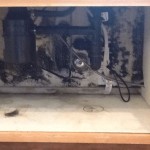Washer Backing Up In Sink: Causes, Solutions, and Prevention
A washing machine backing up into a sink is a common household plumbing issue that can range from a minor inconvenience to a significant problem potentially causing water damage. Understanding the underlying causes of this issue is crucial for effective troubleshooting and prevention. This article will explore the common reasons why a washer might back up into a sink, provide practical solutions for resolving the problem, and outline preventive measures to minimize the risk of recurrence.
Understanding the Plumbing System Connection
The plumbing system in a home is designed to efficiently remove wastewater from various fixtures, including washing machines and sinks. Typically, a washing machine discharges its wastewater through a drain hose connected to a standpipe, which then leads to the main drain line of the house. The sink often shares this same main drain line. When this system functions properly, wastewater flows smoothly away without causing any backflow. However, several factors can disrupt this flow, leading to a washing machine backing up into the sink.
The connection point is particularly important. If the standpipe isn't high enough, or if the drain hose isn't properly secured, siphoning can occur, potentially drawing dirty water back into the sink. Furthermore, inadequate venting in the drain system can create negative pressure, hindering proper drainage and contributing to backflow issues.
Common Causes of Washer Back Up
There are multiple reasons why a washing machine might back up into a sink. The most common culprits include clogs in the drain lines, insufficient drainpipe size, overloaded drains, and plumbing system issues like blocked vents.
Clogs in the Drain Lines: This is undoubtedly the most frequent reason for a washer backing up into a sink. Over time, lint, hair, soap residue, and other debris can accumulate inside the drain lines, gradually reducing the flow capacity. Eventually, this build-up can create a complete blockage, preventing the washing machine from draining properly. As the washing machine pumps out water, the backed-up water seeks the path of least resistance, which is often the sink connected to the same drain line.
The location of the clog can also influence where the water backs up. A clog closer to the washing machine's drain connection is more likely to cause a backup in the nearby sink. Conversely, a clog further down the main drain line might affect multiple fixtures.
Insufficient Drainpipe Size: The size of the drainpipe is a critical factor in its ability to handle the volume of water discharged by a washing machine. If the drainpipe is too small, it simply cannot accommodate the rapid flow of water, leading to backups. This is especially common in older homes where the plumbing system was designed for lower water usage appliances. Modern washing machines tend to use more water, exacerbating the problem.
The diameter of the drainpipe significantly impacts its capacity. A drainpipe that isn't wide enough restricts the flow of water, causing it to back up. This can happen even if there are no significant clogs present, as the drain is simply overwhelmed by the water volume.
Overloaded Drains: Sometimes, the problem isn’t a clog or an undersized drainpipe, but rather an overloaded drain system. If multiple appliances are draining simultaneously into the same drain line, the system might not be able to handle the combined flow. For example, if the washing machine is running at the same time as someone is taking a shower or running the dishwasher, the drain line could become overloaded, causing backups.
The timing of water usage is key. Staggering the use of appliances can help prevent overloading the drain system. For instance, running the washing machine at a different time than the dishwasher or during periods of low water consumption.
Plumbing System Issues (Blocked Vents): Plumbing vents are crucial for maintaining proper drain flow. These vents allow air to enter the drain lines, preventing a vacuum from forming and ensuring that water flows freely. If the vents become blocked, the resulting negative pressure can impede drainage and lead to backups. Debris, such as leaves, nests, or ice, can block vents, particularly outdoor vents.
The location of the vent blockage can influence the severity of the problem. A vent blockage closer to the affected fixture will have a more pronounced effect. Regularly inspecting and clearing vents is critical for optimal drain performance.
Troubleshooting and Solutions
When a washing machine backs up into a sink, a systematic approach is needed to identify and resolve the underlying cause. First, a visual inspection of the immediate area around the washing machine and sink is crucial. Check for any obvious obstructions or leaks. Then, more in-depth troubleshooting steps can be taken.
Clearing Drain Clogs: The initial step is to attempt to clear any obvious clogs. A plunger can be used to dislodge minor blockages in the sink and the standpipe. If plunging is ineffective, a drain snake or auger can be used to reach deeper into the drain line and break up or remove more stubborn clogs. This often requires some manual dexterity and care to avoid damaging the plumbing. One can use a simple hand powered drain snake or a more powerful electric model for tougher clogs.
Chemical drain cleaners are also an option, but should be used with caution. These cleaners can be corrosive and potentially damage pipes, especially older ones. It's important to follow the manufacturer's instructions carefully and avoid using them frequently. For more eco-friendly alternatives, consider using a mixture of baking soda and vinegar followed by hot water.
Inspecting and Cleaning the Drain Hose: Often, the clog may be located within the washing machine's drain hose itself. Detach the drain hose from the standpipe and inspect it for any kinks, bends, or obstructions. Run water through the hose to flush out any loose debris. A flexible brush or small snake can be used to clean the inside of the hose thoroughly. Reattach the drain hose securely to the standpipe, ensuring a tight connection to prevent leaks.
Checking the Standpipe: The standpipe is the vertical pipe that receives the washing machine's drain hose. Ensure that the standpipe is of adequate height, typically at least 30 inches above the floor. If the standpipe is too short, it can contribute to siphoning and backflow. Also, check for any clogs or obstructions in the standpipe itself. A drain snake or auger can be used to clear any blockages.
Addressing Insufficient Drainpipe Size: If the drainpipe is undersized, the best solution is to replace it with a larger diameter pipe. This typically requires the expertise of a qualified plumber. A plumber can assess the existing plumbing system and recommend the appropriate pipe size to handle the washing machine's water discharge volume. This may involve replacing sections of the drain line from the standpipe to the main drain line.
Adjusting Water Usage Habits: As mentioned earlier, overloading the drain system can contribute to backups. Adjusting water usage habits can help alleviate this problem. Avoid running the washing machine at the same time as other water-intensive appliances, such as the dishwasher or showers. Staggering the use of these appliances can reduce the overall load on the drain system.
Clearing Blocked Plumbing Vents: If the plumbing vents are blocked, clearing them is essential for restoring proper drainage. Locate the plumbing vents on the roof and inspect them for any obstructions, such as leaves, nests, or ice. Use a garden hose or a plumbing snake to clear any blockages. If the vents are difficult to access or if you are uncomfortable working on the roof, consider hiring a professional plumber. It is important to ensure that the vent covers are in place to prevent future blockages.
Preventative Measures
Preventing a washer from backing up into a sink is far easier and less disruptive than dealing with the aftermath of a major clog or backflow. Implementing preventative measures can significantly reduce the risk of recurring issues.
Regular Drain Maintenance: Regular drain maintenance is the cornerstone of preventing clogs. Periodically flush the drain lines with hot water to help dissolve soap residue and prevent buildup. Once a month, consider using a drain cleaner or a mixture of baking soda and vinegar followed by hot water to keep the drains clear. Avoid pouring grease or oil down the drain, as these substances can solidify and contribute to clogs.
Lint Traps and Filters: Washing machines often have built-in lint traps or filters to capture lint and debris. Clean these traps or filters regularly to prevent lint from entering the drain lines. A clogged lint trap can reduce the washing machine's draining efficiency and increase the risk of backups.
Proper Drain Hose Installation: Ensure that the washing machine's drain hose is properly installed and secured. The hose should be inserted into the standpipe at the correct height and angle. Use a clamp to secure the hose to the standpipe to prevent it from slipping out. Avoid kinking or bending the hose, as this can restrict water flow and contribute to backups.
Avoid Overloading the Washing Machine: Overloading the washing machine can strain the appliance and increase the amount of lint and debris that enters the drain lines. Follow the manufacturer's recommendations for load size. Smaller loads are easier for the washing machine to process and reduce the risk of clogs.
Professional Plumbing Inspections: Regular plumbing inspections can help identify potential problems before they escalate. A professional plumber can inspect the drain lines, plumbing vents, and other components of the plumbing system to ensure that they are functioning properly. A plumber can also provide recommendations for preventative maintenance and address any underlying plumbing issues.
Use Appropriate Amounts of Detergent: Using excessive amounts of detergent can lead to soap residue buildup in the drain lines. Follow the detergent manufacturer's instructions and use the recommended amount of detergent for each load. Consider using high-efficiency (HE) detergents, which are designed to produce less suds and residue.

How To Fix Water Coming Up Through Your Sink From The Washing Laundry Machine Dishwasher

Washing Machine Waste Backing Up To Kitchen Sink Youtube

Why Is My Washing Machine Backing Up Into Kitchen Sink Yes

Water From Laundry Room Backs Up Into Kitchen Sink

5 Reasons Why There S Water Backing Up In The Kitchen Sink Marco Plumbing Durham Greater Toronto

Why Is My Washing Machine Backing Up Into Kitchen Sink Yes

Dirty Water In The Drum Hoover Advice Centre

Fix That Clogged Laundry Room Sink 1 Tom Plumber

Dishwasher Water Backs Up In Sink Doityourself Com Community Forums

5 Reasons Why There S Water Backing Up In The Kitchen Sink Marco Plumbing Durham Greater Toronto







